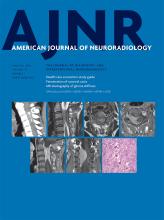Research ArticlePediatric Neuroimaging
Deep Brain Nuclei T1 Shortening after Gadobenate Dimeglumine in Children: Influence of Radiation and Chemotherapy
S. Kinner, T.B. Schubert, R.J. Bruce, S.L. Rebsamen, C.A. Diamond, S.B. Reeder and H.A. Rowley
American Journal of Neuroradiology January 2018, 39 (1) 24-30; DOI: https://doi.org/10.3174/ajnr.A5453
S. Kinner
aFrom the Departments of Radiology (S.K., T.B.S., R.J.B., S.L.R., S.B.R., H.A.R.)
gDepartment of Diagnostic and Interventional Radiology and Neuroradiology (S.K.), University Hospital Essen, Essen, Germany
T.B. Schubert
aFrom the Departments of Radiology (S.K., T.B.S., R.J.B., S.L.R., S.B.R., H.A.R.)
hClinic of Radiology and Nuclear Medicine (T.B.S.), Basel University Hospital, Basel, Switzerland.
R.J. Bruce
aFrom the Departments of Radiology (S.K., T.B.S., R.J.B., S.L.R., S.B.R., H.A.R.)
S.L. Rebsamen
aFrom the Departments of Radiology (S.K., T.B.S., R.J.B., S.L.R., S.B.R., H.A.R.)
C.A. Diamond
bPediatrics (C.A.D.)
S.B. Reeder
aFrom the Departments of Radiology (S.K., T.B.S., R.J.B., S.L.R., S.B.R., H.A.R.)
cMedical Physics (S.B.R.)
dEmergency Medicine (S.B.R.)
eBiomedical Engineering (S.B.R.)
fMedicine (S.B.R.), University of Wisconsin-Madison, Madison, Wisconsin
H.A. Rowley
aFrom the Departments of Radiology (S.K., T.B.S., R.J.B., S.L.R., S.B.R., H.A.R.)

References
- 1.↵
- Errante Y,
- Cirimele V,
- Mallio CA, et al
- 2.↵
- Quattrocchi CC,
- Mallio CA,
- Errante Y, et al
- 3.↵
- 4.↵
- 5.↵
- 6.↵
- Adin ME,
- Kleinberg L,
- Vaidya D, et al
- 7.↵
- 8.↵
- 9.↵
- 10.↵
- 11.↵
- 12.↵
- Radbruch A,
- Weberling LD,
- Kieslich PJ, et al
- 13.↵
- Stojanov D,
- Aracki-Trenkic A,
- Vojinovic S, et al
- 14.↵
- Kanda T,
- Fukusato T,
- Matsuda M, et al
- 15.↵
- Murata N,
- Gonzalez-Cuyar LF,
- Murata K, et al
- 16.↵
- Robert P,
- Lehericy S,
- Grand S, et al
- 17.↵
- Frenzel T,
- Apte C,
- Jost G, et al
- 18.↵
- Jost G,
- Lenhard DC,
- Sieber MA, et al
- 19.↵
- 20.↵
- 21.↵
- Roberts DR,
- Chatterjee AR,
- Yazdani M, et al
- 22.↵
- Roberts DR,
- Holden KR
- 23.↵
- Miller JH,
- Hu HH,
- Pokorney A, et al
- 24.↵
- 25.↵
- Radbruch A,
- Haase R,
- Kickingereder P, et al
- 26.↵
- Kanda T,
- Ishii K,
- Kawaguchi H, et al
- 27.↵
- 28.↵
- 29.↵
- 30.↵
- 31.↵
- Kanal E,
- Maravilla K,
- Rowley HA
- 32.↵
- 33.↵
- Kanda T,
- Oba H,
- Toyoda K, et al
In this issue
American Journal of Neuroradiology
Vol. 39, Issue 1
1 Jan 2018
Advertisement
S. Kinner, T.B. Schubert, R.J. Bruce, S.L. Rebsamen, C.A. Diamond, S.B. Reeder, H.A. Rowley
Deep Brain Nuclei T1 Shortening after Gadobenate Dimeglumine in Children: Influence of Radiation and Chemotherapy
American Journal of Neuroradiology Jan 2018, 39 (1) 24-30; DOI: 10.3174/ajnr.A5453
0 Responses
Jump to section
Related Articles
- No related articles found.
Cited By...
This article has not yet been cited by articles in journals that are participating in Crossref Cited-by Linking.
More in this TOC Section
Pediatric Neuroimaging
Patient Safety
Similar Articles
Advertisement











